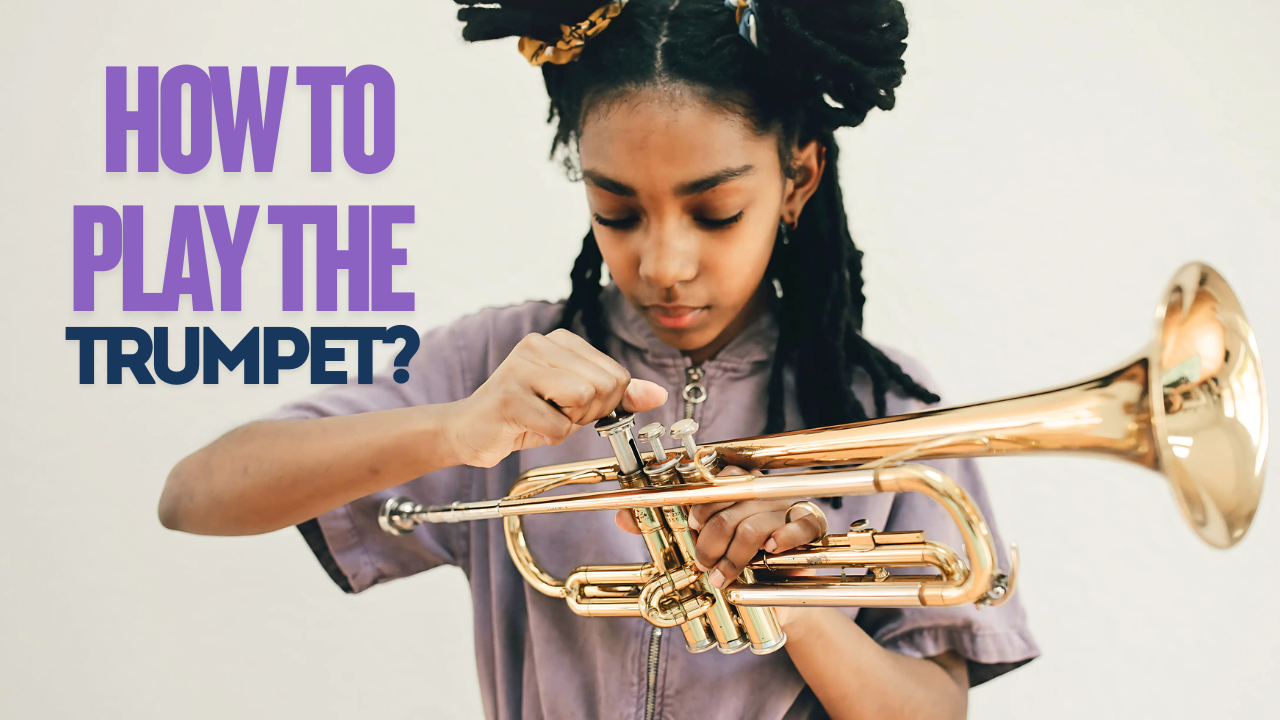Once you open your case with a new trumpet, its shiny finish literally invites you to grab the instrument immediately and start playing. However, there are some steps that you should take before your first music experience. In this article, we will explore how to approach a trumpet the right way to get maximum results.
What Parts Does Your Trumpet Consist Of?
Let’s have a quick review on parts of your trumpet to get a clear picture of what makes up your instrument:

Mouthpiece
This is the part of the trumpet, where the musician blows the air into the instrument. Mouthpieces vary in sizes, depths and forms — each component affects the instrument’s tone and projection.
Leadpipe
This is the tube of the trumpet into which the mouthpiece is inserted. This part is responsible for channeling the air stream into the main body of the instrument.
Valves
The trumpet has three piston valves — the first, second, and third valves. They are responsible for the instrument’s ability to produce a wide range of pitches. Once the trumpeter presses the valve, the airflow within the trumpet is redirected through additional tubing that alters the pitch.
Valve Casings
These are cylindrical parts that the valve pistons fit into.
Valve Slides
Each of the three valves is connected to a slide of a different length, each lowering the pitch of the instrument once it’s pressed down.
The Main Tuning Slide
Located between the mouthpiece receiver and the main tubing, it’s used for adjusting the overall length of the tubing and changing the pitch of the sound that helps to play in tune with other instruments of the ensemble.
Bell
It’s a widened part of the trumpet’s tube, which amplifies the sound and improves its projection and resonance. The material and shape of the bell affects its sound and volume.
Finger Buttons
This is the point of contact between the musician’s fingers and the instrument. Located above each valve casing, finger buttons allow musicians to articulate notes and navigate complex passages. Sometimes you can see these parts of the trumpet decorated with genuine stone inlays.
Water Key
This is the small valve or tap-like component at the end of the instrument allowing you to drain moisture from inside.
How to Get Your Trumpet Ready for Playing the First Time
When you open the case, you will find the instrument and the mouthpiece. Your first step is to insert the mouthpiece into the leadpipe of the trumpet and give it a gentle twist to fix it inside. However, ensure that your mouthpiece is clean and sanitized.
There are several essentials you need to care of on your first day:
-
Slide grease
This product helps trumpet slides move easily. It’s recommended to apply it once you feel your slides dry or getting stuck.
How to Apply: take a small amount of grease with your finger, remove the slide from the instrument and put the grease all over your slide. Work each slide into your instrument independently to distribute the grease inside the internal slide. Repeat the action for all slides that feel sticky
-
Valve oil
This product allows you to keep the valves responsive, helping them move smoothly and fast.
How to Apply: Unscrew the top part of the valve. You should lift the valve almost out of its casing. Put two or three drops of oil onto the valve. Then insert the valve in its casing. Turn the valve until it clicks. Repeat the action for all three valves.
How to Hold Your Trumpet

Your right hand: All three fingers — index, middle and ring — should rest on the top of the valves. Use your fingertips, not flat parts of your fingers. Your little finger should stay on the top. In some cases you can insert it in the ring, for instance when you need to hold your instrument and use a plunger. Ensure you keep your fingers in a C-shape position rather than straight.
Your left hand: Place your hand from the bell side, at the end of the lead pipe, just above the area where it meets the main body. Take a trumpet in a way to stay around the valves with a ring finger in a ring and your thumb in another ring. Keep fingers slightly curved. Your index finger should stay at an angle across all three valves.
Your position: Ensure you stand tall with a straight back with your feet shoulder-width apart. Keep your arms relaxed. If you play in a sitting position, keep your back straight and your feet flat on the floor. Your elbows should be slightly bent and your wrists stay in line with your forearms.
Your lips: Take a breath and create proper embouchure by saying emmm and then saying eee to give your mouth corners a necessary shape. Slightly tighten your lips and make puuu sound with a small aperture between them. Then create a tight seal around the mouthpiece, but avoid pressing it hard onto your face. When you inhale, keep your chin parallel to the ground for proper airflow.
Your trumpet: Hold the instrument at a comfortable angle away. Ensure it stays not too close and not too far away — you should reach all of three valves effortlessly.
Your cheeks: Avoid puffing your cheeks when playing. You may have seen how Dizzy Gillespie did it and that’s not correct, as your air should go into the instrument not stay in your cheeks.
Your tongue: Don’t keep your tongue lying flat down in your mouth as it prevents the air from moving correctly. To bring your tongue in a proper position say Tee. With T-sound you place your tongue behind the teeth arching toward the top of the mouth and this is the exact position where it needs to be for a proper sound.
How to Play the Trumpet
You can begin with buzzing into the mouthpiece alone to train your embouchure. Ensure you place the mouthpiece in the middle of your lips. Once you get the idea of how to produce the sound properly, insert the mouthpiece into the leadpipe and blow into the trumpet without pressing any valves. This will be a G-note. To play F you need to press the first valve down. To play A you need to press the first and the second valves. You can start practicing by moving between G, F, and A to let yourself get used to playing. None of your hands should grip the instrument too tightly to avoid quick fatigue.
Trumpet Accessories That You Need As a Beginner
Now let’s have a quick guide on essential accessories for beginner trumpet players:

- Bag: This protects your delicate instrument from shocks and other damage on your way from home to school and back. It’s important to invest in high-quality bags with a reinforced side for a bell and soft padding to avoid damaging this crucial part and finish of your instrument.
- Trumpet Mouthpiece Pouch: This will save your time for searching mouthpieces in all pockets. It also effectively prevents them from coming into contact with each other. Placed in slots and surrounded by soft lining these components will stay safe from scratches and other defects. Depending on the number of mouthpieces used, you can choose single, double, or triple pouches , or cases for 4 or 7 mouthpieces.
- Valve Guard: These protective covers shield the instrument’s surface from moisture, sweat, and dust. They protect the delicate finish in areas where the instrument regularly contacts the musician's skin. Valve guards also enhance the grip helping players feel more comfortable during extended practice sessions.
- Cleaning Kit: Using these products you can maintain your instrument in the best condition both visually and technically.
Skill Development Tools That You Need As a Beginner Trumpet Player
There are specially designed devices that can improve your embouchure and prevent you from forming harmful habits. Here are some of them:

- Optimizer: This skill development tool helps players improve their embouchure and break the habit of pressing the mouthpiece too tightly against their lips. It’s designed in a way to react to overpressure and signal the player about it by interrupting the buzz. By using it regularly, beginners can quickly develop a proper technique.
- Trumpet Embouchure Trainer: This device helps to control the airflow, enhance lip function, and strengthen the muscles responsible for sound production. Using it you can build your effective warm-up routine.
- Lip Buzzing Tool (BuzzMaster): This device simulates playing the trumpet in the high register helping you refine your technique right from the start. To work with it you don’t actually need the instrument — just your mouthpiece. Thanks to its lightweight construction and compact size it’s ideal for travel and practicing anytime and anywhere to maintain your professional level without breaks.
Useful Habits to Help Beginner Trumpeters Progress Faster
- Useful Habit #1: Slow Down
It’s okay that you want to achieve results as fast as possible, however as a beginner you need time to set the connection between your brain and the muscles engaged in trumpet playing. That’s why it’s necessary to start with a slower tempo that allows you to play the passage as accurately as possible. Comfortable speed allows your brain and muscles to develop the necessary connection. Later, as you get better, you will notice that you can play effortlessly regardless of tempo. But first, practice slower!
- Useful Habit #2: Breathe Correctly
A trumpet is a brasswind instrument so it needs air to produce sound and thus it requires an ability from you to breathe correctly. As a beginner you need to build correct breathing as a habit. With your lungs fully inflated you can push air out and take advantage of it. Once you learn to take full air into your lungs you will be able to play your instrument for a longer time.
Learn to engage your abdominal muscles and lungs with control. With better breathing you leave your facial muscles less work. Train your diaphragmatic breathing, also known as the belly breathing to engage the large muscle at the base of your lungs allowing you to take in more air. Unlike the chest breathing, the diaphragmatic breathing helps brass musicians generate enough air pressure to perform sustained notes with minimal tension on their upper body. To breathe using a diaphragm, put your hand on your abdomen and place the other on your chest. Inhale, feeling how your abdomen expands, while keeping your chest in the same position. Breathe out slowly.
- Useful Habit #3: Accurate Note Changes
This is achieved with precise finger movement. First, ensure that your right hand is in the “holding a beer position” with your thumb placed against the first valve casing and not hooked under the lead pipe. Remove your little finger from the ring to let other fingers move with less tension. Pay attention to how you press the finger buttons. You should lift your fingers high and slap them down on finger buttons with a pop sound.
Conclusion:
These are our recommendations for breaking into a trumpet. By following our advice you can make your practice sessions more rewarding.
We have already mentioned some of our products in this article, but there are more of them in our category of Premium Trumpet Accessories for All Levels.
As a beginner you may face some challenges on your way. Feel free to read our article Trumpet Tips: Avoid Beginner Mistakes to make your progress faster.



 https://kgumusic.com/pages/about-us
https://kgumusic.com/pages/about-us